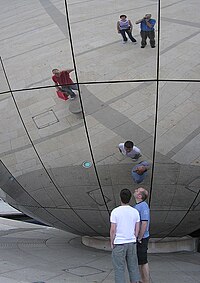
Photo from wikipedia
Traditional distorting mirrors utilize curved surfaces to produce distorted virtual images, i.e., illusions. Here we propose the concept of flat distorting mirrors (FDMs) based on gradient metasurfaces and investigate the… Click to show full abstract
Traditional distorting mirrors utilize curved surfaces to produce distorted virtual images, i.e., illusions. Here we propose the concept of flat distorting mirrors (FDMs) based on gradient metasurfaces and investigate the shape, orientation, and position of the virtual images generated by such FDMs through a ray optics approach. The virtual images can be controlled by varying the distribution of the additional wave vector of the metasurface, which manipulates the deflection of the reflected light. We find that the "effective curvature" of the FDM is related to the derivative of the additional wave vector. When the additional wave vector or its derivative is discontinuous at a certain point, the virtual images can be split. This Letter provides a guide for designing FDMs that create illusions without using curved surfaces.
Journal Title: Optics letters
Year Published: 2021
Link to full text (if available)
Share on Social Media: Sign Up to like & get
recommendations!